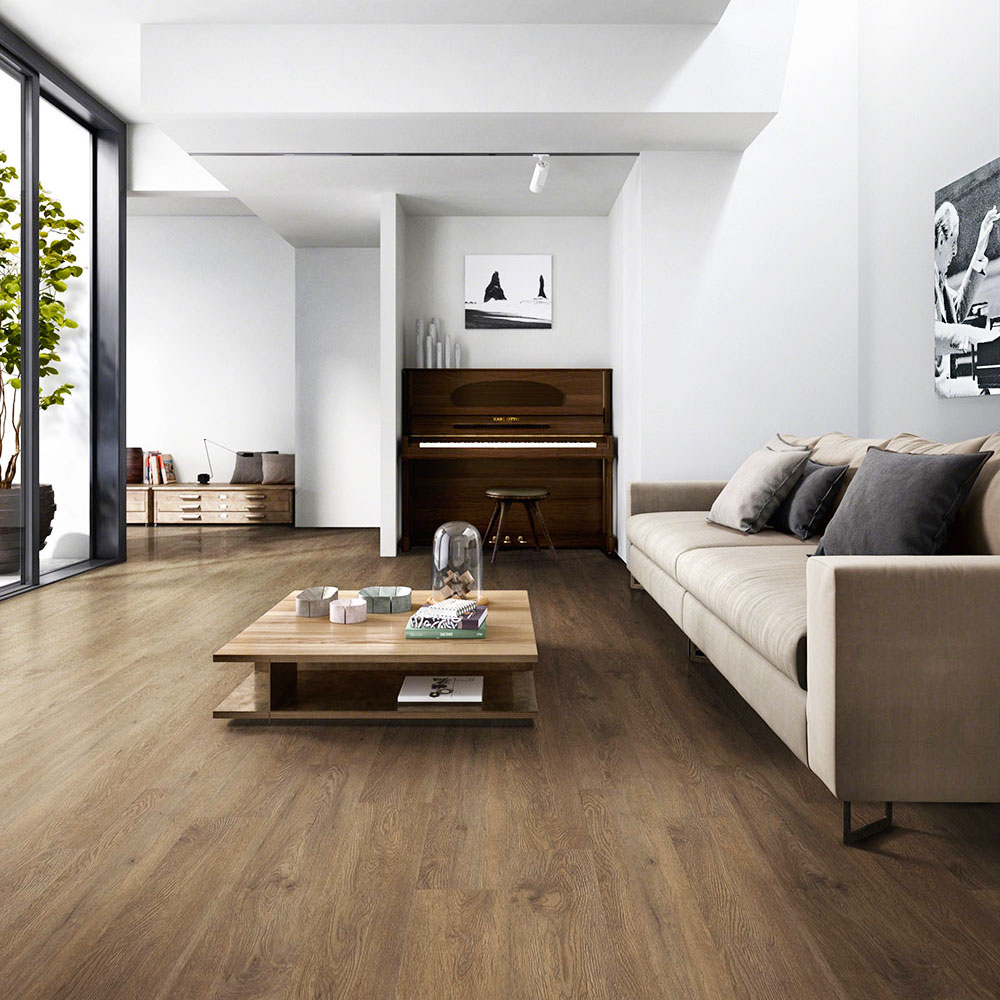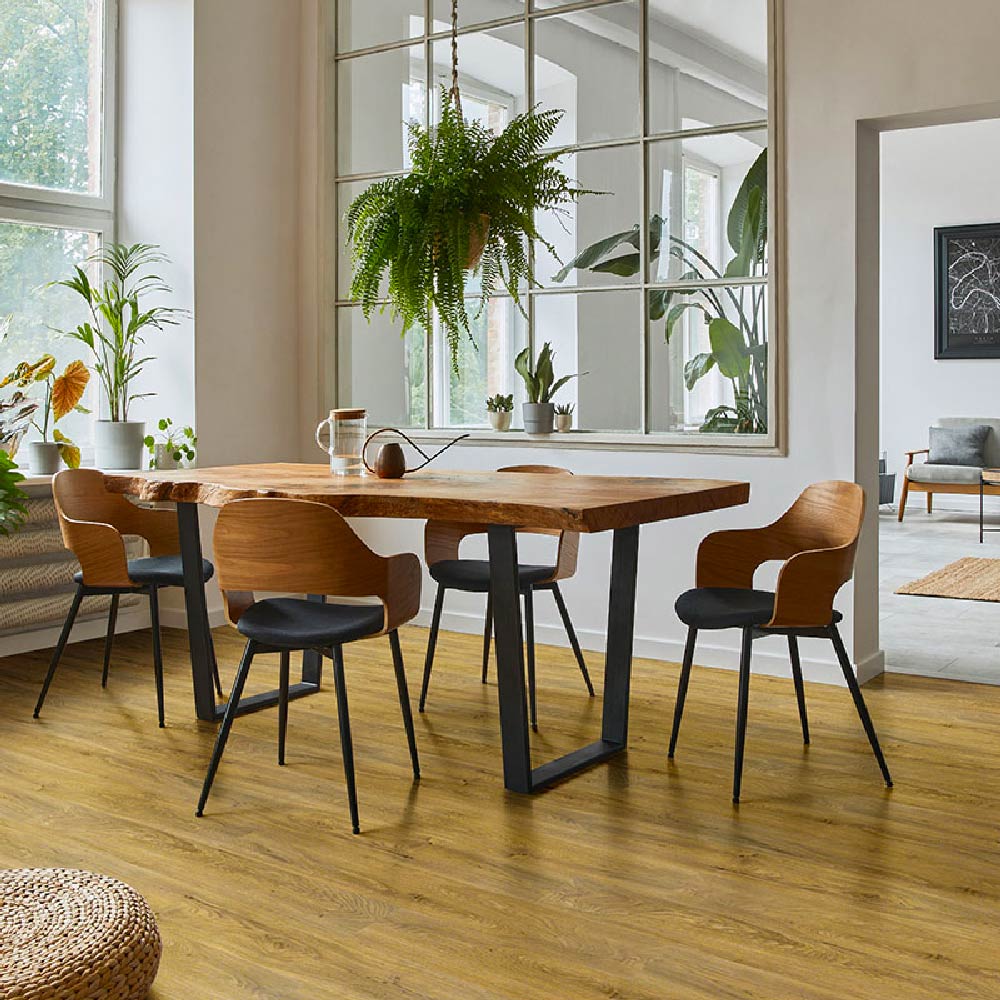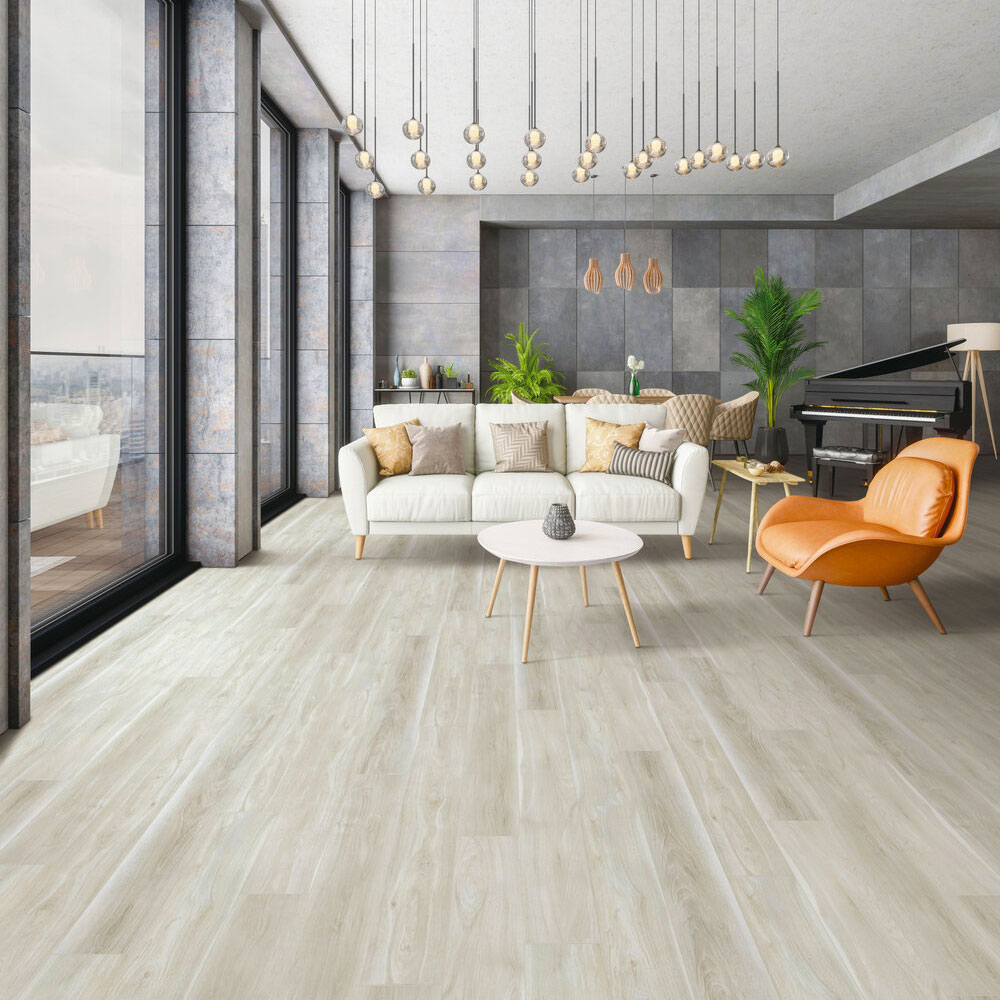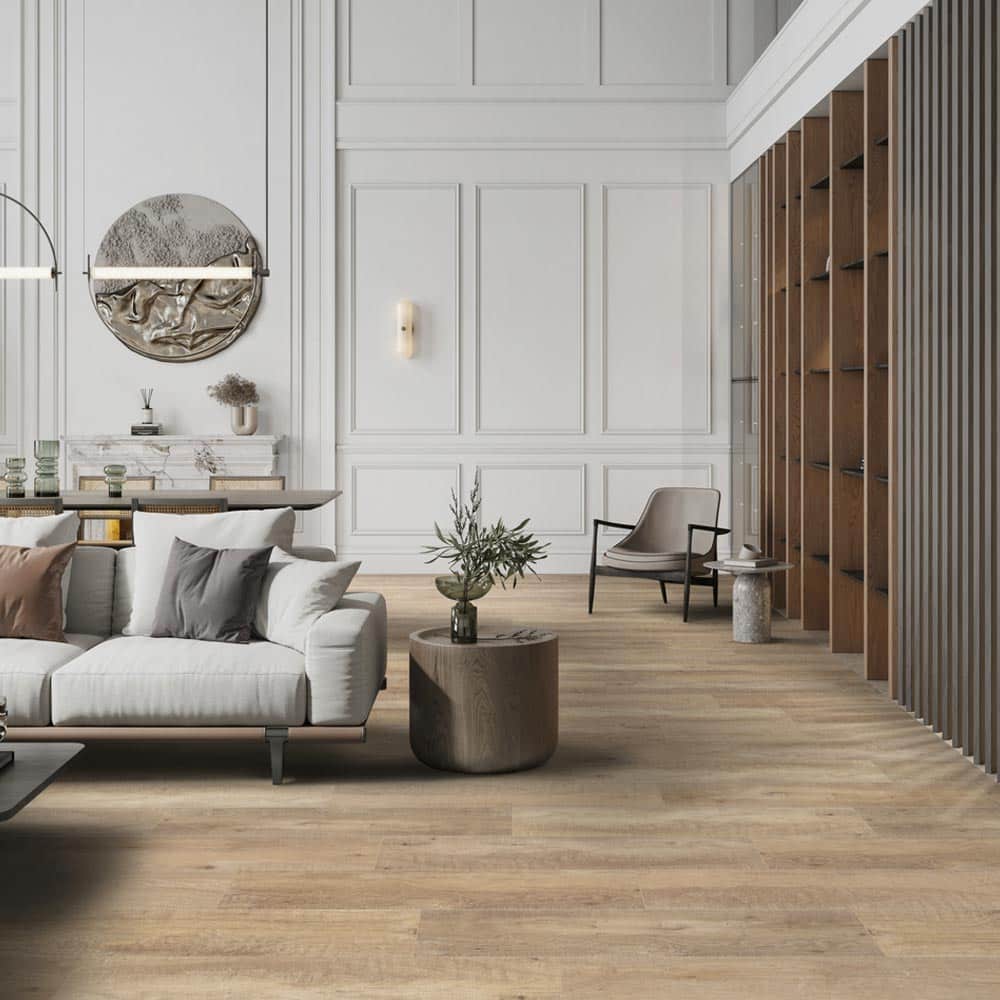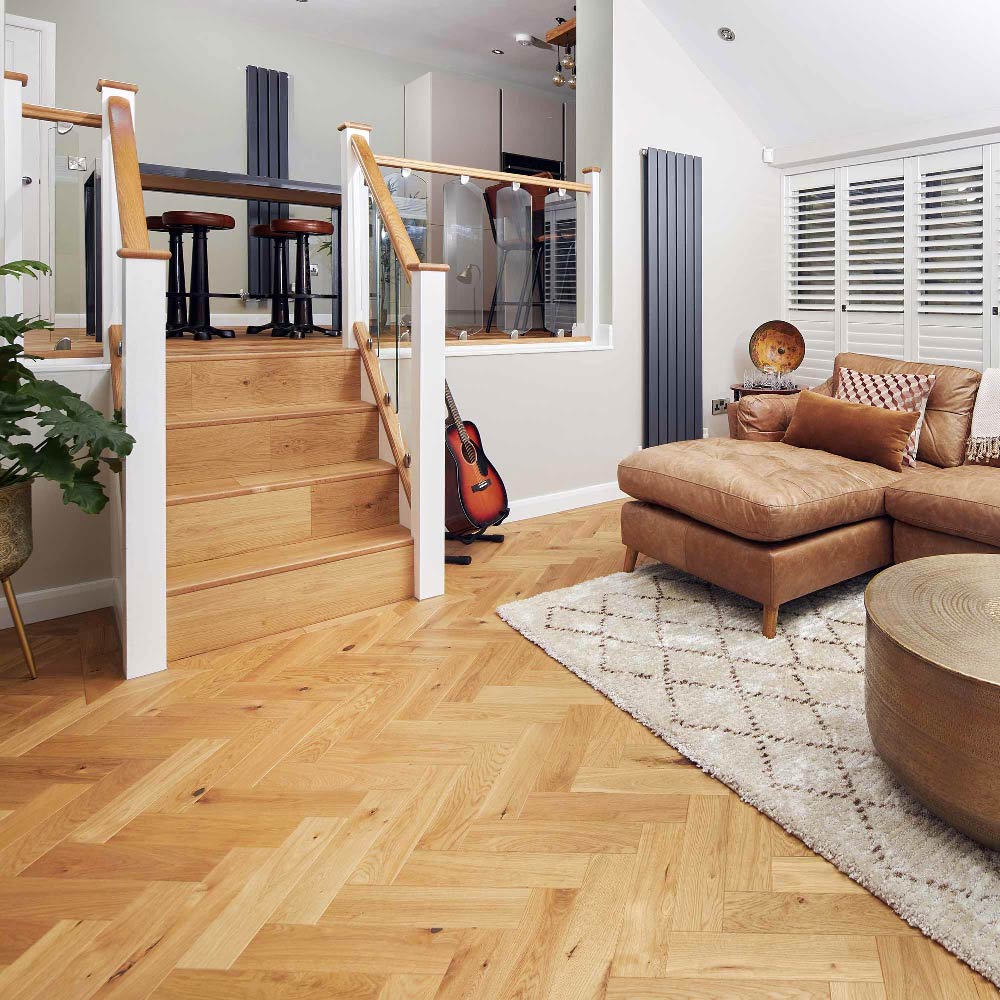Everything you need to know about
Vinyl Flooring
When it comes to creating beautiful floors, there are a plethora of options available in the market. From laminated flooring to vinyl flooring, carpet to tile flooring, and even linoleum flooring, each choice brings its own unique charm and appeal.
Types of Flooring
Laminated Flooring
Description
Laminate flooring has revolutionized the way we think about floor coverings. With its unique composition, it offers a perfect blend of durability, affordability, and aesthetic appeal.
At its core, laminate flooring consists of a particleboard wood base that provides stability and strength. This is topped by an image layer that mimics the look of real wood, stone, or tile. The image layer is then protected by a transparent wear layer that shields the floor from scratches, stains, and fading.
The versatility of laminate floors makes them an ideal choice for various areas in our homes. From living areas to kitchens, dining areas to bedrooms, hallways to other high-traffic zones – laminate floors can withstand it all. They are designed to resist moisture and wear over time, ensuring their longevity even in busy households.
Not only are laminate floors practical and functional, but they also offer endless design possibilities. With a wide range of colours and patterns available in the market today, you can easily find a style that suits your taste and complements your home décor.
Installation
Laminate floors install much like solid hardwood flooring since they have a modified tongue-and-groove style of joining boards. Yet unlike hardwood flooring, which typically requires professional installation, laminate floors are very easy for the do-it-yourselfer to install with only basic tools.
Laminate is always installed as a floating floor. This means that it does not have the difficult nail-down installation issues of hardwood or engineered wood. With the floating floor method, you first roll out inexpensive foam underlayment, tape the underlayment together, and then lay out the laminate planks.
| PRO’s | CON’s |
|---|---|
| > Easy to clean | > Can be ruined by moisture |
| > Scratch resistant | > Top layer may chip |
| > Good for high-impact homes | > Poor for full bathrooms |
| > Relatively inexpensive | > Lower resale value |
Structure
UV layer
This is a layer on the surface of the flooring, the thickness of which is measured in microns. It is cured on the surface of the flooring by UV light. It is also the thinnest layer, but this layer is essential.
The UV layer can have a glossy or matt finish. It protects the surface from stains, resists UV rays and ensures that the floor does not fade after a long period of sunlight exposure.
Wear layer
The wear layer is the part between the UV layer and the decorative layer. The quality and thickness of the wear layer is your indicator for how well your floors will last over time.
Finish layer
The finish layer is usually 4 mil thick or less and is produced by specialized high-definition colour printing equipment. The high-quality finish layer gives the floor a realistic wood or stone grain effect, with a more designed look in terms of colour, pattern and texture.
Core layer
The thickest and hardest layer of the entire SPC flooring. It is the core of the whole floor, made of stone powder and PVC resin powder fused and pressed together to make it completely waterproof. The thickness of the core layer determines the weight of the floor, as well as the thickness of the tongue and groove.
Underlayment
SPC floor coverings are made of EVA or IXPE and are used for sound reduction, heat retention and overall comfort. With thicker underlayment’s comes more sound reduction.
SPC flooring without underlayment can be used if your base floor has a cork layer or if you are laying over an existing wooden floor.
Vinyl Flooring
Vinyl flooring, on the other hand, offers endless possibilities when it comes to design. It can replicate the appearance of natural materials such as wood or stone while providing enhanced durability and water resistance. With its ease of cleaning and ability to withstand heavy foot traffic, vinyl flooring is an excellent option for those seeking both style and practicality.
Description
Vinyl flooring is a product composed of several layers of different materials sandwiched together to form a highly durable, practical and affordable floor covering. The two main types of vinyl flooring are Luxury Vinyl Tiles (LVT) and vinyl roll. Both LVT and vinyl roll are made from the same materials, however, they’re constructed differently to produce different effects. For example the plank format is ideal to imitate natural wood.
Luxury Vinyl Tile (LVT)
LVT is a type of vinyl flooring that is designed to imitate natural flooring options such as hardwood and ceramic tile. Thanks to technological advances and enhanced design capability, vinyl floors can now look and feel nearly identical to the products they’re mimicking. LVT comes in a large variety of timeless and trendy designs, in either tile or plank formats to imitate the look of tiles or wooden planks. It also comes in either rigid or flexible tiles and planks. The modular format of LVT makes it easy and fast to install, a major advantage when renovating a home or a room. Indeed, with LVT, no need to upset the daily routine for too long by closing off one or several rooms. Renovating with LVT can be done with the furniture still in the room.
Installation
The installation process for glue down vinyl flooring involves applying an adhesive to the subfloor with a trowel and then laying the vinyl planks or tiles onto the adhesive. This ensures that the flooring sticks firmly to the subfloor, creating a strong and sturdy foundation for the flooring.
Glue down vinyl flooring is often used in commercial settings, such as schools, hospitals, and offices, due to its durability and resistance to heavy foot traffic. However, it is also a popular choice for residential homes, especially in areas with high moisture levels or where the flooring will be exposed to water, such as kitchens and bathrooms.
| PRO’s | CON’s |
|---|---|
| > comfortable & quiet underfoot | > Can be ruined by moisture |
| > resistant to damage & moisture | > Top layer may chip |
| > Easy to install and maintain | > Poor for full bathrooms |
| > Affordable | > Lower resale value |
| > large number of colours and designs |
Structure
Luxury vinyl (LVT) is generally a hardwood floor alternative composed of two or more distinct layers of hardened plastic, along with a protective wear layer coating.
Luxury vinyl products can be either flexible or rigid. Rigid-core vinyl is also known as EVP flooring, and it’s generally the higher-quality option as far as underfoot feel. Some manufacturers incorporate wood flour or stone powder into these rigid cores for enhanced qualities.
Vinyl Roll Flooring
Vinyl roll is fibreglass-cushion-backed flooring that comes in large, continuous, flexible sheets, and is available in an almost limitless number of styles, from timeless and realistic to more playful designs. Vinyl rolls are also one of the most affordable flooring solutions for homeowners. Also, Vinyl rolls are 100% phthalate-free and have low VOC and formaldehyde emissions, and UK allergy certified, which contribute to healthier indoor environments.
How durable is vinyl flooring?
Vinyl flooring is generally considered to be a highly durable material. There are, however, important factors that determine how well your floor lasts over time. For instance, the quality of the material, how it was manufactured, and how well it was installed, will all impact the durability and life expectancy of your vinyl flooring.
All Tarkett vinyl floors, both our LVT and vinyl roll ranges, are treated with a special PUR surface treatment, which provides extreme protection and makes them even more durable and resistant to scratches or stains. They also have a transparent wear layer, which provides additional durability. Our Rigid LVT also has an enhanced rigid core construction, providing extra resistance and excellent dimensional stability. As a result, it won’t ripple or swell, and there won’t be any expansion or contraction of the floor over time. The product will hold its shape and size against moisture or temperature variations. Water, cold or heat, won’t alter Rigid LVT’s appearance. In fact, its top coat is so durable it helps protect it against all kinds of damage. Also, it’s a great flooring option for high traffic areas and for anyone looking for a high quality but low maintenance floor.
How long do vinyl floors last?
Vinyl floors can last anywhere from 5 to 25 years, depending on their quality and how they’re installed and maintained.
| PRO’s | CON’s |
|---|---|
| > comfortable & quiet underfoot | > Difficult to remove if glued down |
| > resistant to damage & moisture | > Can dent with heavy objects on top of it |
| > Easy to install and maintain | > Can be punctured with very sharp objects |
| > Affordable | > Unable to support very high temperatures |
| > large number of colours and designs | > May show fading and discolouration with excessive UV exposure |
Installation
Vinyl flooring is so easy to install that you can have a whole new look to any room in your home in just one weekend. Exactly how to install your vinyl floor depends on the type of product you choose. And in the case of vinyl roll flooring, we recommend loose-lay installation up to 50m2, therefore, a knife and double-sided tape is all you need.
Structure
Vinyl Roll sheet vinyl is made of several layers. The backing is the bottom layer that lies against the subfloor or underlayment. On top of the backing, a fiberglass dimensional layer gives the flooring strength. Next, a printed layer provides flooring with its attractive design. Then a tough wear layer protects the printed layer from damage. And finally, the finish layer makes the flooring easy to clean and often includes UV protectants to prevent fading or yellowing.
For those who crave comfort underfoot, carpet is an unbeatable choice. Its soft texture creates a cozy atmosphere while providing insulation and sound absorption. Available in various colors, patterns, and textures, carpets add warmth and elegance to any space.
Tile flooring exudes timeless beauty with its vast array of options ranging from ceramic to porcelain tiles. Known for their durability and resistance to moisture, tile floors are perfect for high-traffic areas like kitchens or bathrooms. Whether you prefer sleek modern designs or intricate mosaic patterns, tile flooring offers endless possibilities for creating stunning floors.
Lastly, linoleum flooring has made a comeback in recent years due to its eco-friendly nature. Made from natural materials such as linseed oil and cork powder, linoleum is not only visually appealing but also sustainable. With an extensive range of colors available, linoleum allows you to create vibrant floors that make a statement while being kinder to the environment.
No matter which type of beautiful floor you choose – be it laminated flooring that combines affordability with style, vinyl flooring that offers endless design possibilities, the cozy comfort of carpet, the timeless elegance of tile flooring, or the eco-friendly charm of linoleum – each option has its own unique way of transforming a space into something truly remarkable. So go ahead and unleash your creativity to create floors that not only reflect your personal style but also elevate your living environment to new heights of beauty.

